二语习得复习资料
- 格式:doc
- 大小:168.50 KB
- 文档页数:15
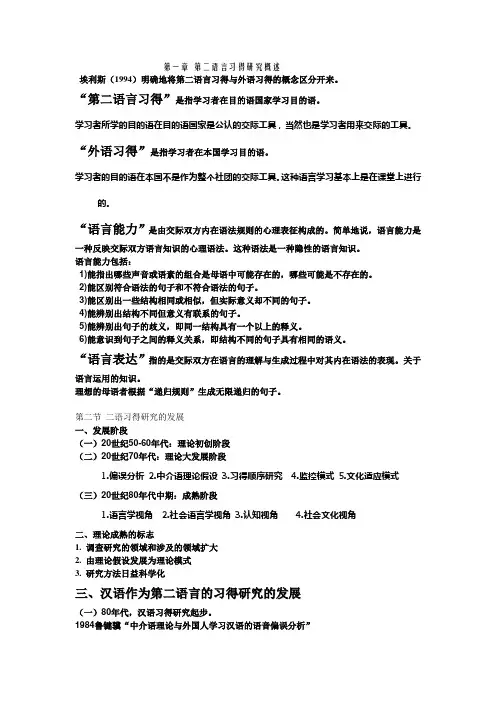
第一章第二语言习得研究概述埃利斯(1994)明确地将第二语言习得与外语习得的概念区分开来。
“第二语言习得”是指学习者在目的语国家学习目的语。
学习者所学的目的语在目的语国家是公认的交际工具,当然也是学习者用来交际的工具。
“外语习得”是指学习者在本国学习目的语。
学习者的目的语在本国不是作为整个社团的交际工具。
这种语言学习基本上是在课堂上进行的。
“语言能力”是由交际双方内在语法规则的心理表征构成的。
简单地说,语言能力是一种反映交际双方语言知识的心理语法。
这种语法是一种隐性的语言知识。
语言能力包括:1)能指出哪些声音或语素的组合是母语中可能存在的,哪些可能是不存在的。
2)能区别符合语法的句子和不符合语法的句子。
3)能区别出一些结构相同或相似,但实际意义却不同的句子。
4)能辨别出结构不同但意义有联系的句子。
5)能辨别出句子的歧义,即同一结构具有一个以上的释义。
6)能意识到句子之间的释义关系,即结构不同的句子具有相同的语义。
“语言表达”指的是交际双方在语言的理解与生成过程中对其内在语法的表现。
关于语言运用的知识。
理想的母语者根据“递归规则”生成无限递归的句子。
第二节二语习得研究的发展一、发展阶段(一)20世纪50-60年代:理论初创阶段(二)20世纪70年代:理论大发展阶段1.偏误分析2.中介语理论假设3.习得顺序研究4.监控模式5.文化适应模式(三)20世纪80年代中期:成熟阶段1.语言学视角2.社会语言学视角3.认知视角4.社会文化视角二、理论成熟的标志1. 调查研究的领域和涉及的领域扩大2. 由理论假设发展为理论模式3. 研究方法日益科学化三、汉语作为第二语言的习得研究的发展(一)80年代,汉语习得研究起步。
1984鲁键骥“中介语理论与外国人学习汉语的语音偏误分析”1985年,第一界国际汉语教学讨论会1987年,吕必松“加强对外汉语教学的理论研究”评价:取得了一定成果,但缺乏系统研究、分析方法不够严谨、疏于解释和评价。
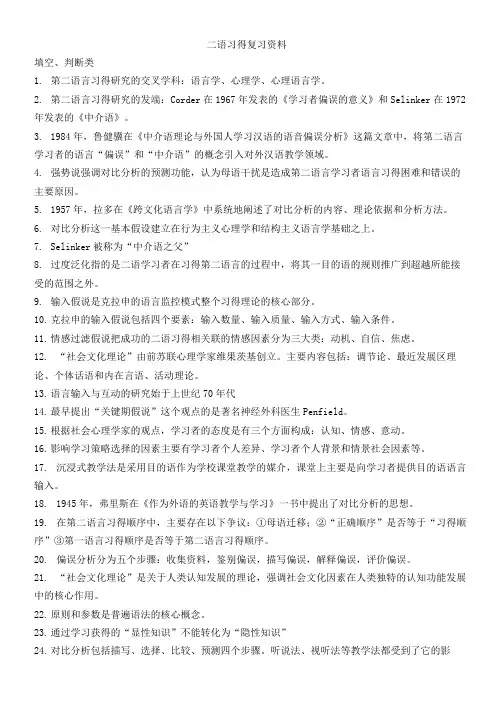
二语习得复习资料填空、判断类1.第二语言习得研究的交叉学科:语言学、心理学、心理语言学。
2.第二语言习得研究的发端:Corder在1967年发表的《学习者偏误的意义》和Selinker在1972年发表的《中介语》。
3.1984年,鲁健骥在《中介语理论与外国人学习汉语的语音偏误分析》这篇文章中,将第二语言学习者的语言“偏误”和“中介语”的概念引入对外汉语教学领域。
4.强势说强调对比分析的预测功能,认为母语干扰是造成第二语言学习者语言习得困难和错误的主要原因。
5.1957年,拉多在《跨文化语言学》中系统地阐述了对比分析的内容、理论依据和分析方法。
6.对比分析这一基本假设建立在行为主义心理学和结构主义语言学基础之上。
7.Selinker被称为“中介语之父”8.过度泛化指的是二语学习者在习得第二语言的过程中,将其一目的语的规则推广到超越所能接受的范围之外。
9.输入假说是克拉申的语言监控模式整个习得理论的核心部分。
10.克拉申的输入假说包括四个要素:输入数量、输入质量、输入方式、输入条件。
11.情感过滤假说把成功的二语习得相关联的情感因素分为三大类:动机、自信、焦虑。
12.“社会文化理论”由前苏联心理学家维果茨基创立。
主要内容包括:调节论、最近发展区理论、个体话语和内在言语、活动理论。
13.语言输入与互动的研究始于上世纪70年代14.最早提出“关键期假说”这个观点的是著名神经外科医生Penfield。
15.根据社会心理学家的观点,学习者的态度是有三个方面构成:认知、情感、意动。
16.影响学习策略选择的因素主要有学习者个人差异、学习者个人背景和情景社会因素等。
17.沉浸式教学法是采用目的语作为学校课堂教学的媒介,课堂上主要是向学习者提供目的语语言输入。
18.1945年,弗里斯在《作为外语的英语教学与学习》一书中提出了对比分析的思想。
19.在第二语言习得顺序中,主要存在以下争议:①母语迁移;②“正确顺序”是否等于“习得顺序”③第一语言习得顺序是否等于第二语言习得顺序。
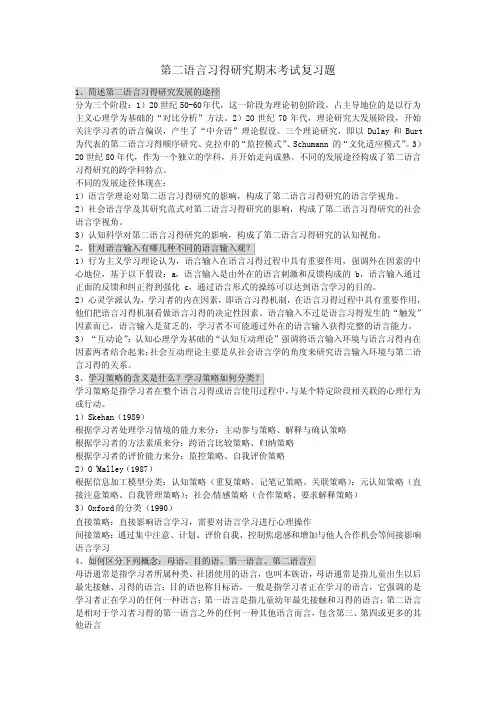
第二语言习得研究期末考试复习题1、简述第二语言习得研究发展的途径分为三个阶段:1)20世纪50-60年代,这一阶段为理论初创阶段,占主导地位的是以行为主义心理学为基础的“对比分析”方法。
2)20世纪70年代,理论研究大发展阶段,开始关注学习者的语言偏误,产生了“中介语”理论假设。
三个理论研究,即以Dulay和Burt 为代表的第二语言习得顺序研究、克拉申的“监控模式”、Schumann的“文化适应模式”。
3)20世纪80年代,作为一个独立的学科,并开始走向成熟。
不同的发展途径构成了第二语言习得研究的跨学科特点。
不同的发展途径体现在:1)语言学理论对第二语言习得研究的影响,构成了第二语言习得研究的语言学视角。
2)社会语言学及其研究范式对第二语言习得研究的影响,构成了第二语言习得研究的社会语言学视角。
3)认知科学对第二语言习得研究的影响,构成了第二语言习得研究的认知视角。
2、针对语言输入有哪几种不同的语言输入观?1)行为主义学习理论认为,语言输入在语言习得过程中具有重要作用,强调外在因素的中心地位,基于以下假设:a,语言输入是由外在的语言刺激和反馈构成的 b,语言输入通过正面的反馈和纠正得到强化 c,通过语言形式的操练可以达到语言学习的目的。
2)心灵学派认为,学习者的内在因素,即语言习得机制,在语言习得过程中具有重要作用,他们把语言习得机制看做语言习得的决定性因素。
语言输入不过是语言习得发生的“触发”因素而已,语言输入是贫乏的,学习者不可能通过外在的语言输入获得完整的语言能力。
3)“互动论”:认知心理学为基础的“认知互动理论”强调将语言输入环境与语言习得内在因素两者结合起来;社会互动理论主要是从社会语言学的角度来研究语言输入环境与第二语言习得的关系。
3、学习策略的含义是什么?学习策略如何分类?学习策略是指学习者在整个语言习得或语言使用过程中,与某个特定阶段相关联的心理行为或行动。
1)Skehan(1989)根据学习者处理学习情境的能力来分:主动参与策略、解释与确认策略根据学习者的方法素质来分:跨语言比较策略、归纳策略根据学习者的评价能力来分:监控策略、自我评价策略2)O’Malley(1987)根据信息加工模型分类:认知策略(重复策略、记笔记策略、关联策略);元认知策略(直接注意策略、自我管理策略);社会/情感策略(合作策略、要求解释策略)3)Oxford的分类(1990)直接策略:直接影响语言学习,需要对语言学习进行心理操作间接策略:通过集中注意、计划、评价自我、控制焦虑感和增加与他人合作机会等间接影响语言学习4、如何区分下列概念:母语、目的语、第一语言、第二语言?母语通常是指学习者所属种类、社团使用的语言,也叫本族语,母语通常是指儿童出生以后最先接触、习得的语言;目的语也称目标语,一般是指学习者正在学习的语言,它强调的是学习者正在学习的任何一种语言;第一语言是指儿童幼年最先接触和习得的语言;第二语言是相对于学习者习得的第一语言之外的任何一种其他语言而言,包含第三、第四或更多的其他语言5、简述社会文化理论的主要内容及意义主要内容:调节论:主要用于解释儿童的认知发展,在语言的调节下,儿童的认知从“客体调控”阶段发展到“他人调控”阶段,最后到“自我调控”阶段。
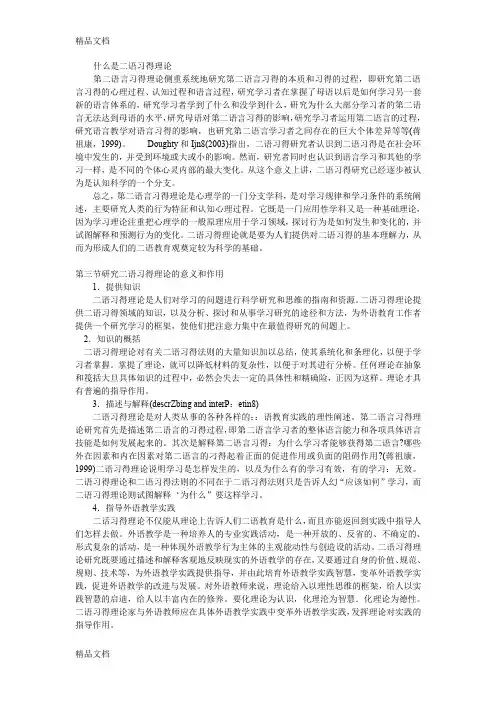
什么是二语习得理论第二语言习得理论侧重系统地研究第二语言习得的本质和习得的过程,即研究第二语言习得的心理过程、认知过程和语言过程,研究学习者在掌握了母语以后是如何学习另一套新的语言体系的,研究学习者学到了什么和没学到什么,研究为什么大部分学习者的第二语言无法达到母语的水平,研究母语对第二语言习得的影响,研究学习者运用第二语言的过程,研究语言教学对语言习得的影响,也研究第二语言学习者之间存在的巨大个体差异等等(蒋祖康,1999)。
Doughty和Ijn8(2003)指出,二语习得研究者认识到二语习得是在社会环境中发生的,并受到环境或大或小的影响。
然而,研究者同时也认识到语言学习和其他的学习一样,是不同的个体心灵内部的最大变化。
从这个意义上讲,二语习得研究已经逐步被认为是认知科学的一个分支。
总之,第二语言习得理论是心理学的一门分支学科,是对学习规律和学习条件的系统阐述,主要研究人类的行为特征和认知心理过程。
它既是一门应用性学科又是一种基础理论,因为学习理论注重把心理学的一般原理应用于学习领域,探讨行为是如何发生和变化的,并试图解释和预测行为的变化。
二语习得理论就是要为人们提供对二语习得的基本理解力,从而为形成人们的二语教育观奠定较为科学的基础。
第三节研究二语习得理论的意义和作用1.提供知识二语习得理论是人们对学习的问题进行科学研究和思维的指南和资源。
二语习得理论提供二语习得领域的知识,以及分析、探讨和从事学习研究的途径和方法,为外语教育工作者提供一个研究学习的框架,使他们把注意力集中在最值得研究的问题上。
2.知识的概括二语习得理论对有关二语习得法则的大量知识加以总结,使其系统化和条理化,以便于学习者掌握。
掌提了理论,就可以降低材料的复杂性,以便于对其进行分桥。
任何理论在抽象和筏括大旦具体知识的过程中,必然会失去一定的具体性和精确险,正因为这样。
理论才具有普遍的指导作用。
3.描述与解释(descrZbing and interP:etin8)二语习得理论是对人类从事的各种各样的::语教育实践的理性阐述。
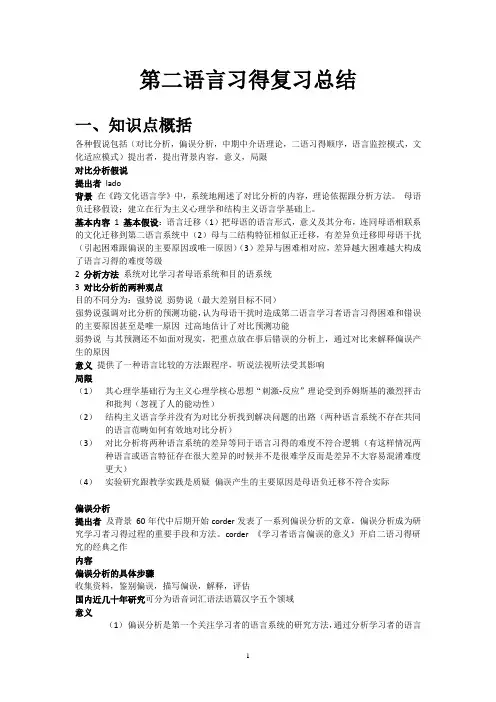
第二语言习得复习总结一、知识点概括各种假说包括(对比分析,偏误分析,中期中介语理论,二语习得顺序,语言监控模式,文化适应模式)提出者,提出背景内容,意义,局限对比分析假说提出者lado背景在《跨文化语言学》中,系统地阐述了对比分析的内容,理论依据跟分析方法。
母语负迁移假设;建立在行为主义心理学和结构主义语言学基础上。
基本内容1 基本假设:语言迁移(1)把母语的语言形式,意义及其分布,连同母语相联系的文化迁移到第二语言系统中(2)母与二结构特征相似正迁移,有差异负迁移即母语干扰(引起困难跟偏误的主要原因或唯一原因)(3)差异与困难相对应,差异越大困难越大构成了语言习得的难度等级2分析方法系统对比学习者母语系统和目的语系统3 对比分析的两种观点目的不同分为:强势说弱势说(最大差别目标不同)强势说强调对比分析的预测功能,认为母语干扰时造成第二语言学习者语言习得困难和错误的主要原因甚至是唯一原因过高地估计了对比预测功能弱势说与其预测还不如面对现实,把重点放在事后错误的分析上,通过对比来解释偏误产生的原因意义提供了一种语言比较的方法跟程序,听说法视听法受其影响局限(1)其心理学基础行为主义心理学核心思想“刺激-反应”理论受到乔姆斯基的激烈抨击和批判(忽视了人的能动性)(2)结构主义语言学并没有为对比分析找到解决问题的出路(两种语言系统不存在共同的语言范畴如何有效地对比分析)(3)对比分析将两种语言系统的差异等同于语言习得的难度不符合逻辑(有这样情况两种语言或语言特征存在很大差异的时候并不是很难学反而是差异不大容易混淆难度更大)(4)实验研究跟教学实践是质疑偏误产生的主要原因是母语负迁移不符合实际偏误分析提出者及背景60年代中后期开始corder发表了一系列偏误分析的文章,偏误分析成为研究学习者习得过程的重要手段和方法。
corder 《学习者语言偏误的意义》开启二语习得研究的经典之作内容偏误分析的具体步骤收集资料,鉴别偏误,描写偏误,解释,评估国内近几十年研究可分为语音词汇语法语篇汉字五个领域意义(1)偏误分析是第一个关注学习者的语言系统的研究方法,通过分析学习者的语言偏误来观察和分析第二语言学习者的习得过程和习得机制,成为二语习得研究的起点。
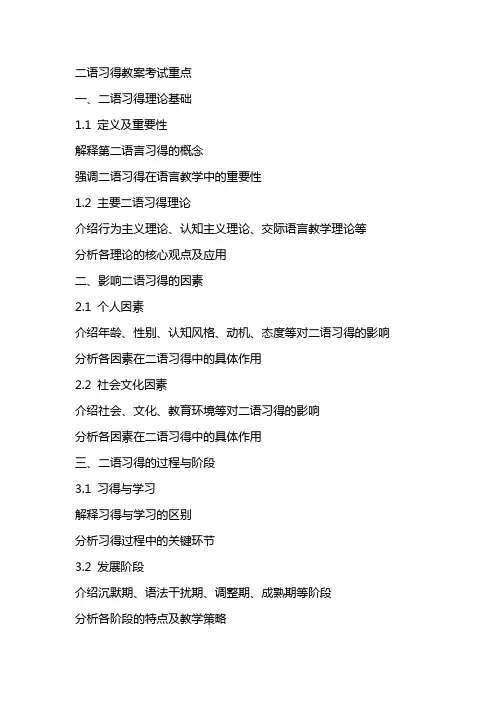
二语习得教案考试重点一、二语习得理论基础1.1 定义及重要性解释第二语言习得的概念强调二语习得在语言教学中的重要性1.2 主要二语习得理论介绍行为主义理论、认知主义理论、交际语言教学理论等分析各理论的核心观点及应用二、影响二语习得的因素2.1 个人因素介绍年龄、性别、认知风格、动机、态度等对二语习得的影响分析各因素在二语习得中的具体作用2.2 社会文化因素介绍社会、文化、教育环境等对二语习得的影响分析各因素在二语习得中的具体作用三、二语习得的过程与阶段3.1 习得与学习解释习得与学习的区别分析习得过程中的关键环节3.2 发展阶段介绍沉默期、语法干扰期、调整期、成熟期等阶段分析各阶段的特点及教学策略四、二语习得教学策略与应用4.1 教学方法与技巧介绍直接法、听说法、交际法等教学方法分析各种方法在二语习得中的应用及效果4.2 教学设计强调以学习者为中心的教学设计原则分析如何根据学习者的需求、兴趣、水平等因素设计教学活动五、评估与测试5.1 评估方式介绍口试、笔试、课堂观察等评估方式分析各种评估方式的优缺点及适用场景5.2 测试设计与分析介绍如何设计有效的二语习得测试分析测试结果,为教学提供反馈和建议六、语言输入与输出在二语习得中的作用6.1 语言输入解释语言输入的概念及重要性探讨如何提供足够的、适合学生水平的语言输入6.2 语言输出解释语言输出的概念及重要性探讨如何通过语言输出促进学生的语言习得七、语言迁移与二语习得7.1 语言迁移概述解释语言迁移的概念及类型(正迁移、负迁移)探讨语言迁移对二语习得的影响7.2 减少语言迁移的策略分析如何通过教学策略帮助学生减少语言迁移介绍避免错误、利用已有知识等策略八、语言习得中的错误分析8.1 错误分类介绍错误分类及常见错误类型分析各种错误产生的原因及特点8.2 错误处理策略探讨如何正确处理学生在二语习得过程中的错误介绍宽容对待、纠正与反馈等策略九、二语习得与外语教学9.1 课程设置与教材选择分析如何根据二语习得理论设置课程及选择教材强调课程内容、教学目标与学习者需求的一致性9.2 教师角色与专业发展探讨教师在二语习得过程中的角色分析教师如何通过专业发展提高教学质量十、二语习得研究及其启示10.1 研究方法与成果介绍二语习得研究的主要方法与成果分析各种研究对教学实践的启示10.2 发展趋势与展望分析二语习得领域的发展趋势展望未来二语习得研究对教学实践的指导作用十一、学习策略与二语习得11.1 学习策略的概念与分类解释学习策略的概念及分类,如认知策略、调控策略、交际策略等。
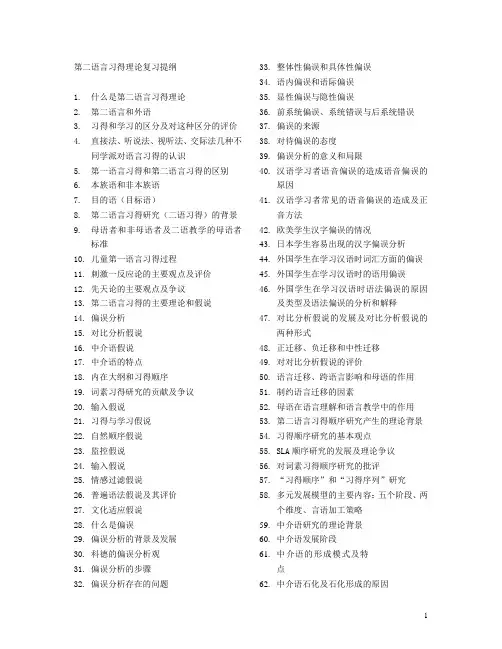
第二语言习得理论复习提纲1.什么是第二语言习得理论2.第二语言和外语3.习得和学习的区分及对这种区分的评价4.直接法、听说法、视听法、交际法几种不同学派对语言习得的认识5.第一语言习得和第二语言习得的区别6.本族语和非本族语7.目的语(目标语)8.第二语言习得研究(二语习得)的背景9.母语者和非母语者及二语教学的母语者标准10.儿童第一语言习得过程11.刺激一反应论的主要观点及评价12.先天论的主要观点及争议13.第二语言习得的主要理论和假说14.偏误分析15.对比分析假说16.中介语假说17.中介语的特点18.内在大纲和习得顺序19.词素习得研究的贡献及争议20.输入假说21.习得与学习假说22.自然顺序假说23.监控假说24.输入假说25.情感过滤假说26.普遍语法假说及其评价27.文化适应假说28.什么是偏误29.偏误分析的背景及发展30.科德的偏误分析观31.偏误分析的步骤32.偏误分析存在的问题33.整体性偏误和具体性偏误34.语内偏误和语际偏误35.显性偏误与隐性偏误36.前系统偏误、系统错误与后系统错误37.偏误的来源38.对待偏误的态度39.偏误分析的意义和局限40.汉语学习者语音偏误的造成语音偏误的原因41.汉语学习者常见的语音偏误的造成及正音方法42.欧美学生汉字偏误的情况43.日本学生容易出现的汉字偏误分析44.外国学生在学习汉语时词汇方面的偏误45.外国学生在学习汉语时的语用偏误46.外国学生在学习汉语时语法偏误的原因及类型及语法偏误的分析和解释47.对比分析假说的发展及对比分析假说的两种形式48.正迁移、负迁移和中性迁移49.对对比分析假说的评价50.语言迁移、跨语言影响和母语的作用51.制约语言迁移的因素52.母语在语言理解和语言教学中的作用53.第二语言习得顺序研究产生的理论背景54.习得顺序研究的基本观点55.SLA顺序研究的发展及理论争议56.对词素习得顺序研究的批评57.“习得顺序”和“习得序列”研究58.多元发展模型的主要内容:五个阶段、两个维度、言语加工策略59.中介语研究的理论背景60.中介语发展阶段61.中介语的形成模式及特点62.中介语石化及石化形成的原因63.中介语的变异性64.中介语研究对第二语言教学的启示65.语言输入和输出的关系66.Krashen的输入假说及争议67.课堂教学中老师如何把握语言输入和输出68.语言输入需进一步研究的问题69.学习者的个体因素及对二语习得的影响70.语言学能71.学习策略和交际策略、交际策略的类型72.元认知策略73.语言学习的动机74.影响语言学习态度的几个方面75.什么是语言环境?76.社会环境对语言学习的影响77.课堂语言环境与第二语言学习。
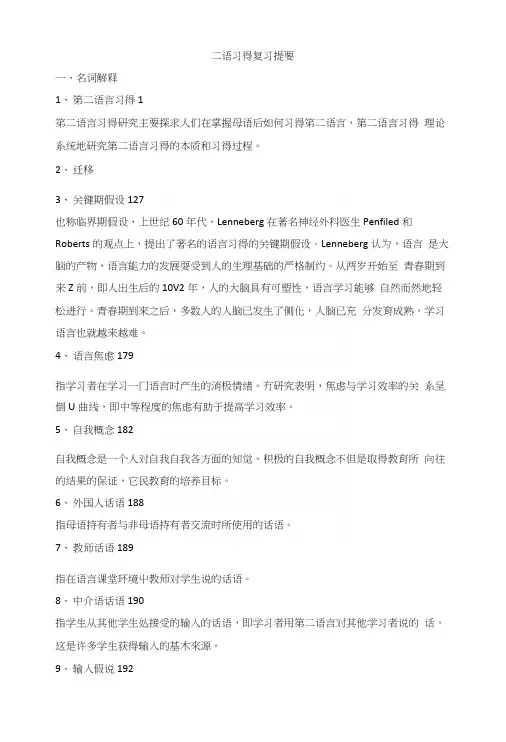
二语习得复习提要一、名词解释1、第二语言习得1笫二语言习得研究主要探求人们在掌握母语后如何习得笫二语言,第二语言习得理论系统地研究第二语言习得的本质和习得过程。
2、迁移3、关键期假设127也称临界期假设,上世纪60年代,Lenneberg在著名神经外科医生Penfiled和Roberts的观点上,提出了著名的语言习得的关键期假设。
Lenneberg认为,语言是大脑的产物,语言能力的发展耍受到人的生理基础的严格制约。
从两岁开始至青春期到来Z前,即人出生后的10V2年,人的大脑具有可塑性,语言学习能够自然而然地轻松进行。
青春期到來之后,多数人的人脑已发生了侧化,人脑已充分发育成熟,学习语言也就越来越难。
4、语言焦虑179指学习者在学习一门语言时产生的消极情绪。
冇研究表明,焦虑与学习效率的关系呈倒U曲线,即中等程度的焦虑有助于提高学习效率。
5、自我概念182自我概念是一个人对自我自我各方面的知觉。
积极的自我概念不但是取得教育所向往的结果的保证,它民教育的培养目标。
6、外国人话语188指母语持有者与非母语持有者交流时所使用的话语。
7、教师话语189指在语言课堂环境屮教师对学生说的话语。
8、中介语话语190指学生从其他学生处接受的输入的话语,即学习者用第二语言对其他学习者说的话,这是许多学生获得输入的基木來源。
9、输入假说192一些研究者把可理解输入看做是二语习得的一个主导因素,Krashen的输入假说是其中最有代表性的。
Krashen强调人类只通过理解信息或接受可理解输入习得语言。
他的输入假设的主要观点是:耍使语言习得得以发生,有必耍让学习者理解的输入语言包含稍高于其现冇水平的项目。
学习者利用情境提示理解这些语言,最后语言能力自然产生而无需传受。
他认为理想的输入应该有四个特征:可理解性,趣味及关联性,非语法程序安排,要有足够的输入量。
10、Swain的输出假设195该假设的思想概括起来,即通过产生出语言,口头的或者书面的,语言习得可以发生。
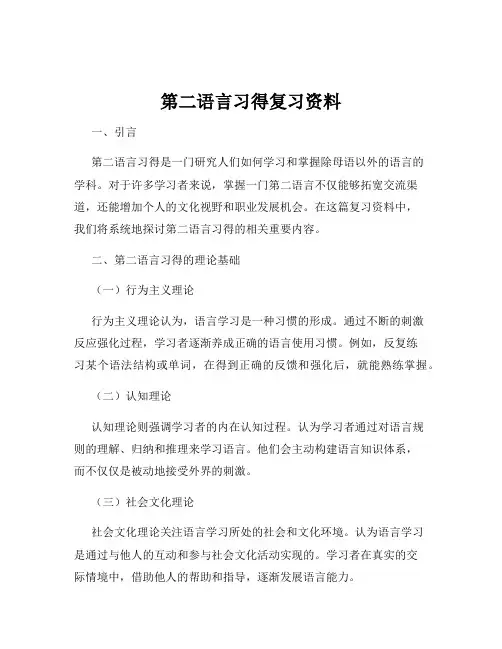
第二语言习得复习资料一、引言第二语言习得是一门研究人们如何学习和掌握除母语以外的语言的学科。
对于许多学习者来说,掌握一门第二语言不仅能够拓宽交流渠道,还能增加个人的文化视野和职业发展机会。
在这篇复习资料中,我们将系统地探讨第二语言习得的相关重要内容。
二、第二语言习得的理论基础(一)行为主义理论行为主义理论认为,语言学习是一种习惯的形成。
通过不断的刺激反应强化过程,学习者逐渐养成正确的语言使用习惯。
例如,反复练习某个语法结构或单词,在得到正确的反馈和强化后,就能熟练掌握。
(二)认知理论认知理论则强调学习者的内在认知过程。
认为学习者通过对语言规则的理解、归纳和推理来学习语言。
他们会主动构建语言知识体系,而不仅仅是被动地接受外界的刺激。
(三)社会文化理论社会文化理论关注语言学习所处的社会和文化环境。
认为语言学习是通过与他人的互动和参与社会文化活动实现的。
学习者在真实的交际情境中,借助他人的帮助和指导,逐渐发展语言能力。
三、第二语言习得的关键因素(一)语言输入丰富、准确、可理解的语言输入对于第二语言习得至关重要。
这包括听、读等多种形式的输入。
例如,听英语广播、阅读英语书籍等。
(二)语言输出学习者不仅要接受输入,还需要有机会进行语言输出,如说、写。
通过输出,学习者能够检验自己的语言知识,发现不足并加以改进。
(三)学习动机强烈的学习动机能够推动学习者积极投入学习。
动机可以是内在的,如对语言本身的兴趣;也可以是外在的,如为了通过考试或获得工作机会。
(四)学习策略有效的学习策略能够提高学习效率。
比如记忆策略、认知策略、元认知策略等。
学习者要学会根据自己的情况选择和运用合适的策略。
四、第二语言习得的阶段(一)初始阶段在这个阶段,学习者通常对第二语言的语音、词汇和基本语法有初步的了解和接触,但使用能力有限。
(二)中级阶段学习者能够进行简单的交流,掌握更多的语法和词汇,但在表达上可能还存在一些错误。
(三)高级阶段学习者能够较为流利和准确地运用第二语言进行交流,对语言的理解和运用达到较高水平。

第二语言习得复习题一、名词解释1.第二语言:指相对于第一语言来说,除儿童幼年最先接触和习得的语言,在此后习得的语言就是第二语言。
2. 第一语言:指儿童幼年最先接触和习得的语言。
3. 母语:指学习者所属种族、社团使用的语言,也称作“本族语”。
4,目的语:也叫目标语,一般指学习者正在学习的语言。
5,第二语言习得:简称SLA,是指人们在获得母语(第一语言)的基础上习得另一种或几种语言的过程。
也叫“二语习得”6,语言习得机制:乔姆斯基提出人脑中存在一个“语言习得机制”(LAD),它有以下一些特点:1.具有遗传性,为人类独有。
2.能使儿童加工语言材料,判断语言体系的发展,建立抽象规则。
3.可能已经具备一些普遍的语言特征,这些特征可以在所有人类语言中找到,因此,许多语法属性可能是先天存在于人类的大脑中,无需学习。
7,工具型动机:学习者对目的语群体没有兴趣,学习目的语只是为了掌握一个工具,用来提高自己的知识水平、改善社会地位。
8,习得与学习:克拉申认为“习得”通常指在自然状态下“下意识”的语言获得,而“学习”一般是指“有意识”的语言获得。
前者称为“内隐学习”,后者称为“外显学习”9,中介语:语言学习者在学习第二语言时所拥有的一种独立的语言系统,这种语言系统在结构上既不是学习者的母语也不是目的语,而是介于两者之间。
中介语系统在语音、词汇、语法、文化等方面都有表现。
但它又不是固定不变的,而是随着学习的发展,逐渐向目的语的正确形式靠拢。
10,普遍语法:乔姆斯基认为普遍语法是由一些原则条件和规则构成的系统,这些所有人类语言共有的因素是或特性是必然的而不是偶然的,原则系统和规则系统。
11,僵化:僵化(fossilization),也叫化石化或石化,是由Selinker于1972年在其中介语理论中提出的。
僵化是存在于“潜在的心理结构”中的一种机制,表现为某种母语背景的第二语言学习者会在目的语习得的某个阶段上停滞不前,无论学习者年龄大小,也无论其是否继续学习12,外国人话语:所谓“外国人话语”并不是指外国人的话语,而是指对外国人说的话语。
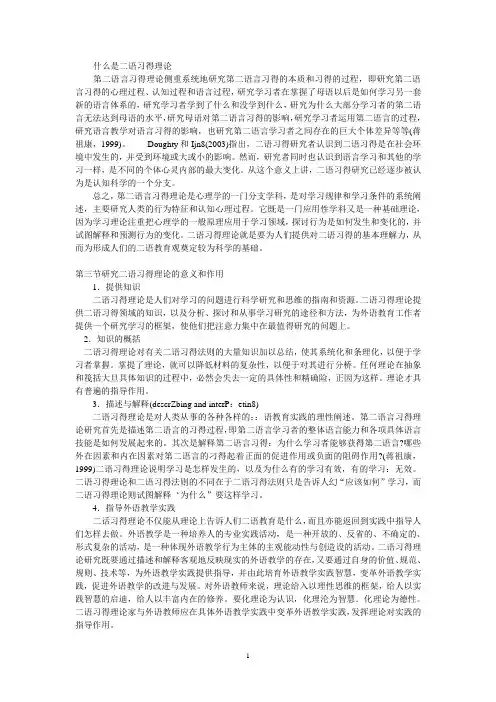
什么是二语习得理论第二语言习得理论侧重系统地研究第二语言习得的本质和习得的过程,即研究第二语言习得的心理过程、认知过程和语言过程,研究学习者在掌握了母语以后是如何学习另一套新的语言体系的,研究学习者学到了什么和没学到什么,研究为什么大部分学习者的第二语言无法达到母语的水平,研究母语对第二语言习得的影响,研究学习者运用第二语言的过程,研究语言教学对语言习得的影响,也研究第二语言学习者之间存在的巨大个体差异等等(蒋祖康,1999)。
Doughty和Ijn8(2003)指出,二语习得研究者认识到二语习得是在社会环境中发生的,并受到环境或大或小的影响。
然而,研究者同时也认识到语言学习和其他的学习一样,是不同的个体心灵内部的最大变化。
从这个意义上讲,二语习得研究已经逐步被认为是认知科学的一个分支。
总之,第二语言习得理论是心理学的一门分支学科,是对学习规律和学习条件的系统阐述,主要研究人类的行为特征和认知心理过程。
它既是一门应用性学科又是一种基础理论,因为学习理论注重把心理学的一般原理应用于学习领域,探讨行为是如何发生和变化的,并试图解释和预测行为的变化。
二语习得理论就是要为人们提供对二语习得的基本理解力,从而为形成人们的二语教育观奠定较为科学的基础。
第三节研究二语习得理论的意义和作用1.提供知识二语习得理论是人们对学习的问题进行科学研究和思维的指南和资源。
二语习得理论提供二语习得领域的知识,以及分析、探讨和从事学习研究的途径和方法,为外语教育工作者提供一个研究学习的框架,使他们把注意力集中在最值得研究的问题上。
2.知识的概括二语习得理论对有关二语习得法则的大量知识加以总结,使其系统化和条理化,以便于学习者掌握。
掌提了理论,就可以降低材料的复杂性,以便于对其进行分桥。
任何理论在抽象和筏括大旦具体知识的过程中,必然会失去一定的具体性和精确险,正因为这样。
理论才具有普遍的指导作用。
3.描述与解释(descrZbing and interP:etin8)二语习得理论是对人类从事的各种各样的::语教育实践的理性阐述。
二语习得复习资料填空、判断类1、第二语言习得研究得交叉学科:语言学、心理学、心理语言学。
2、第二语言习得研究得发端:Corder在1967年发表得《学习者偏误得意义》与Selinker在1972年发表得《中介语》。
3、 1984年,鲁健骥在《中介语理论与外国人学习汉语得语音偏误分析》这篇文章中,将第二语言学习者得语言“偏误”与“中介语”得概念引入对外汉语教学领域。
4、强势说强调对比分析得预测功能,认为母语干扰就是造成第二语言学习者语言习得困难与错误得主要原因。
5、 1957年,拉多在《跨文化语言学》中系统地阐述了对比分析得内容、理论依据与分析方法。
6、对比分析这一基本假设建立在行为主义心理学与结构主义语言学基础之上。
7、 Selinker被称为“中介语之父”。
8、过度泛化指得就是二语学习者在习得第二语言得过程中,将其一目得语得规则推广到超越所能接受得范围之外。
9、输入假说就是克拉申得语言监控模式整个习得理论得核心部分。
10、克拉申得输入假说包括四个要素:输入数量、输入质量、输入方式、输入条件。
11、情感过滤假说把成功得二语习得相关联得情感因素分为三大类:动机、自信、焦虑。
12、“社会文化理论”由前苏联心理学家维果茨基创立。
主要内容包括:调节论、最近发展区理论、个体话语与内在言语、活动理论。
13、语言输入与互动得研究始于上世纪70年代14、最早提出“关键期假说”这个观点得就是著名神经外科医生Penfield。
15、根据社会心理学家得观点,学习者得态度就是有三个方面构成:认知、情感、意动。
16、影响学习策略选择得因素主要有学习者个人差异、学习者个人背景与情景社会因素等。
17、沉浸式教学法就是采用目得语作为学校课堂教学得媒介,课堂上主要就是向学习者提供目得语语言输入。
18、 1945年,弗里斯在《作为外语得英语教学与学习》一书中提出了对比分析得思想。
19、在第二语言习得顺序中,主要存在以下争议:①母语迁移;②“正确顺序”就是否等于“习得顺序”;③第一语言习得顺序就是否等于第二语言习得顺序。
名词解释:1、母语:指学习者所属种族、社团使用的语言,因而也称作“本族语”,一般情况下,母语是儿童出生以后最先接触、习得的语言2、目的语:也称“目标语”,是指学习者正在学习的语言,这种语言可以指正在学习的母语或第一语言,也可以指他正在学习的第二语言、第三语言甚至第四语言。
3、第一语言:指儿童幼年最先接触和习得的语言。
4、第二语言:是相对于学习者习得的第一语言之外任何一种其他语言。
5、习得:指“非正式”的语言获得,儿童大都是通过这种方式来获得母语。
6、学习:指“正式”的语言规则学习,即通过课堂教学的方式来获得第二语言。
7、第二语言习得:指学习者在目的语国家学习目的语。
8、外语习得:指学习者在本国学习除母语外的目的语。
9、语言能力:指是一种反映交际双发语言知识的心理语法。
10、语言表达:指的是交际双发在语言的理解与生成过程中对其内在的语法运用。
11、对比分析:产生于20世纪50年代。
兴盛于60年代。
初衷是为了在第二语言教学中预测学习者的难点,预防学习者的语言偏误,提高第二语言教学的效率。
12、母语负迁移:这一假设的实质是母语在第二语言习得中的作用问题,主张对比分析的学者认为。
学习者的母语对第二语言习得将产生极大的影响,如第二语言学习者学习外语大都有母语的“口语”。
13、内隐学习:是通过无意识或下意识的方式来获得语言知识,外显学习是在有意识的状态下通过规则学习,来获得语言知识。
14、通过学习获得的“显性知识”不能转化为“隐性知识”一、第二语言习得研究的跨学科特点:语言学与心理学有着交叉与重合,构成了心理语言学,第二语言习得研究与语言学密切相关,但是在学科的划分上,它并不属于语言学,同样,第二语言习得研究与心理语言学也密切相关,但他既不属于心理语言学也不属于心理学。
二、第二语言习得研究的发端:第二语言习得研究的发端可以追溯到20世纪60年代末,Corder1967年发表的《学习者偏误的意义》明确提出了第二语言习得的研究对象,标志着第二语言习得研究成为一个相对独立的研究领域;Selinker1972发表的《中介语》,系统地阐述了“中介语”理论假设,更加明确的提出了第二语言习得研究的对象,即“学习者的语言系统”,因此,这两人的文章被称为第二语言习得研究的“开山之作”,成为建立第二语言习得研究学科的标志。
第二语言习得研究考试资料试题知识点首先,为了更好地了解第二语言习得研究的相关知识点和考试内容,我们需要对这一领域进行深入研究。
本文将介绍第二语言习得研究的一些主要知识点,并提供一些考试资料试题,以帮助读者全面了解和掌握该领域的核心概念和重要内容。
第一部分:第二语言习得概述在本部分,我们将对第二语言习得的基本概念进行介绍,包括定义、研究方法和重要理论等。
第1知识点:第二语言习得的定义第二语言习得指的是个体在已经掌握第一语言的基础上,通过接触和学习第二语言来获得其语言能力的过程。
与第二语言学习不同,第二语言习得强调通过语言输入和交际环境的共同作用,自然地获得语言能力。
第2知识点:第二语言习得的研究方法第二语言习得的研究方法主要包括观察研究、实验研究和问卷调查等。
观察研究通过观察第二语言习得者的行为和语言产出,来了解其习得过程。
实验研究通过控制变量和实验条件,对第二语言习得进行实验性的研究。
问卷调查则通过调查问卷来收集第二语言习得者的相关数据。
第3知识点:第二语言习得的重要理论在第二语言习得研究中,有多个重要理论被提出和讨论,比如克里奥特斯理论、输入假设以及认知语言学等。
这些理论从不同角度解释了第二语言习得的过程和机制,为研究者提供了理论基础和研究框架。
第二部分:第二语言习得的影响因素在本部分,我们将介绍影响第二语言习得的一些主要因素,包括年龄因素、语言输入、认知因素等。
第4知识点:年龄因素对第二语言习得的影响年龄因素是影响第二语言习得的重要因素之一。
研究表明,儿童在早期习得第二语言时更容易实现母语水平的掌握,而成年人在第二语言习得上会遇到一些困难。
这主要与儿童期语言习得的生理机制和神经可塑性有关。
第5知识点:语言输入对第二语言习得的影响语言输入是指第二语言习得者在习得过程中接触到的语言材料。
研究发现,输入的丰富性和质量对于第二语言习得者的语言习得有着重要影响。
良好的语言输入能够提供更多的习得机会和语言模型,促进语言能力的发展。
第二语言习得复习总结一、知识点概括各种假说包括(对比分析,偏误分析,中期中介语理论,二语习得顺序,语言监控模式,文化适应模式)提出者,提出背景内容,意义,局限对比分析假说提出者lado背景在《跨文化语言学》中,系统地阐述了对比分析的内容,理论依据跟分析方法。
母语负迁移假设;建立在行为主义心理学和结构主义语言学基础上。
基本内容1基本假设:语言迁移(1)把母语的语言形式,意义及其分布,连同母语相联系的文化迁移到第二语言系统中(2)母与二结构特征相似正迁移,有差异负迁移即母语干扰(引起困难跟偏误的主要原因或唯一原因)(3)差异与困难相对应,差异越大困难越大构成了语言习得的难度等级2分析方法系统对比学习者母语系统和目的语系统3对比分析的两种观点目的不同分为:强势说弱势说(最大差别目标不同)强势说强调对比分析的预测功能,认为母语干扰时造成第二语言学习者语言习得困难和错误的主要原因甚至是唯一原因过高地估计了对比预测功能弱势说与其预测还不如面对现实,把重点放在事后错误的分析上,通过对比来解释偏误产生的原因意义提供了一种语言比较的方法跟程序,听说法视听法受其影响局限(1)其心理学基础行为主义心理学核心思想“刺激-反应”理论受到乔姆斯基的激烈抨击和批判(忽视了人的能动性)(2)结构主义语言学并没有为对比分析找到解决问题的出路(两种语言系统不存在共同的语言范畴如何有效地对比分析)(3)对比分析将两种语言系统的差异等同于语言习得的难度不符合逻辑(有这样情况两种语言或语言特征存在很大差异的时候并不是很难学反而是差异不大容易混淆难度更大)(4)实验研究跟教学实践是质疑偏误产生的主要原因是母语负迁移不符合实际偏误分析提出者及背景60年代中后期开始corder发表了一系列偏误分析的文章,偏误分析成为研究学习者习得过程的重要手段和方法。
corder《学习者语言偏误的意义》开启二语习得研究的经典之作内容偏误分析的具体步骤收集资料,鉴别偏误,描写偏误,解释,评估国内近几十年研究可分为语音词汇语法语篇汉字五个领域意义(1)偏误分析是第一个关注学习者的语言系统的研究方法,通过分析学习者的语言偏误来观察和分析第二语言学习者的习得过程和习得机制,成为二语习得研究的起点。
《第二语习得理论》复习纲要第一章引言1、二语习得研究者的研究对象一般是群体,而不是个体,你如何看待这个问题?10二语习得研究中,研究者的研究对象一般是群体,研究结论也是对某个群体而言。
但作为二语教学的老师,他更加关注一个个的个体,他关心的是如何让每一个学生很好的掌握第二语言。
这种情况下,二语习得研究者得到的结论,很可能对进行教学的老师的指导意义不是很大。
因此,二语习得研究者有必要加强对个体的研究,而不是局限于群体。
2、你认为什么是学外语的最好方式?9第二章人1、什么是一语习得的行为主义模型?提出者是?16-17一语习得的天生论模型的理论基础是乔姆斯基的转换生成语法,天生论认为人的大脑中有一个语言习得的机制,小孩出生后在任何一个语言环境中,都能利用这个语言习得机制学会所在环境的语言。
这种观点与观察到的现象是一致的,所以有较强的解释力。
2、什么是一语习得的天生论模型?18-193、什么是一语习得的社会互动模型,提出者是?20-214、什么是文化适应模型?如何评价?24-255^ 什么是perceived social distance?(另一个是social distance,在文化适应模式节)26 perceived social distance 是与social distance 相关的一个概念o Social distance 通常指人们在社会经济地位方面的差别,而perceived social distance则指学习者内部因素的差别(比如对讲所学语言的人的态度,对讲这种语言的社会的态度,对讲这种语言的人的文化价值观念的态度等)。
Acton 研究了perceived social distance与学习成绩之间的关系,研究结果表明,态度介于两种语言文化价值观的学生,学习成绩最理想。
6、文化适应分哪几个阶段?29-307、什么是言语适应模型?是谁提出来的?30-31二语学习者对所学语言文化的态度影响学习过程,言语适应模型认为人们之间的交谈包含三个不同的过程,即交谈双方保持他们各自的说话方式,让各自的说话方式与对方显得越发不同,双方采用对方的说话特点以相互靠拢。
二语习得复习资料第一章(填空+名词解释)第一节第二语言习得的基本概念母语:通常指的是学习者幼年习得的语言。
由于母语是家庭或者所属种族、社团使用的语言,因而也称作“本族语”。
一般说来,母语通常是儿童出生以后最先接触、学会的语言。
因此,母语通常也被称作“第一语言”。
目的语:也称“目标语”,一般是指学习者正在学习的语言。
第一语言:指儿童幼年最先接触和习得的语言。
第二语言强调的是语言习得的先后顺序,与语言习得环境无关。
“习得”是一种下意识、非正式的类似儿童母语的获得过程。
学习者通常意识不到他们正在学习语言这一事实,但是能意识到他们正在用语言进行交际。
“学习”是指有意识地、正式的学习语言知识,能够明确地意识到所学的规则。
克拉申把这两个方式看作彼此独立的学习过程。
无接口观点、有接口的观点“第二语言习得”是指学习者在目的语国家学习目的语。
该目的语在目的语国家是公认的交际工具,当然也是学习者用来交际的工具。
“外语习得”是指学习者在本国学习目的语。
该目的语在本国不是作为整个社团的交际工具。
“自然的第二语言习得”是指以交际的方式获得第二语言,而且语言习得通常是在自然的社会环境下发生的。
“有指导的第二语言习得”是以教学指导的方式获得第二语言,语言习得通常是在课堂教学环境中发生的。
“语言能力”美国语言学家乔姆斯基首先提出了“语言能力”的概念。
其含义是,人类先天具有的、受遗传因素决定的掌握语言规则的能力。
这里所说的语言能力是指人们掌握语言知识的能力。
“语言表达”——在实际生活中运用语言进行社会交往的能力。
美国社会语言学家海姆斯第一次提出交际能力的概念,它包括四个方面的内容:语法性、可行性、得体性、现实性。
第三节第二语言习得发端发展简要回顾1.第二语言习得研究作为一门独立的学科是以1967年S.P.Corder(科德)发表的颇具影响的论文《学习者偏误的意义》以及1972年Selinker(塞林格)的《中介语》为标志。
2.第二语言习得研究发展历程:第一阶段:20世纪50—60年代对比分析第二阶段:70年代“中介语”理论第二语言习得顺序“监控模式”文化适应模式第三阶段:80年代中期至今受多学科影响第二章第一节对比分析1.对比分析,是通过对第二语言学习者母语与目的语在语音、词汇、语法等方面的系统对比,找出两者之间的异同,从而预测第二语言学习者可能遇到的语言困难和可能产生的语言错误,进而采取一定的教学手段,以达到教学中避免或减少第二语言学习者的错误的目的。
Chapter 4nguage and the brain1)Broca’s area, which is usually associated with the production of language, or languageoutputs .2)Wernicke's area, which is associated with the processing of words that we hear beingspoken, or language inputs3)Lateralization: language activity is not localized, but core linguistic processes are typicallyhoused in the left hemisphere and is present to some extent even in infancy4)Critical Period Hypothesis: children had only a limited number of years during which theycould acquire their L1 flawlessly; brain plasticity in childhood would allow other areas of the brain to take over the language functions of the damaged areas, but beyond a certain age, normal language would not be possible.5)①How independent are the languages of multilingual speakers?there are three possibility for how language relate in an individual’s mind◆Coordinate bilingualism: refers to parallel linguistic systems, independent of oneanother◆Compound bilingualism : refers to a fused and unified system◆Subordinate bilingualism: refers to one linguistic system accessed throughanother②How are multiple language structures organized in relation to one another in the brain?Are both languages stored in the same areas?◆there is considerable variation among speakers. For at least some multilinguals, itappears that L1 and L2 are stored in somewhat different areas of the brain, but both arepredominantly in (probably overlapping) areas of the left hemisphere. However, theright hemisphere might be more involved in L2 than in L1.③Does the organization of the brain for L2 in relation to L1 differ with age of acquisition,how it is learned, or level of proficiency?◆The answer is probably “yes”to all three, with the strongest body of evidenceshowing that age of acquisition influences brain organization for many second languagelearners④Do two or more languages show the same sort of loss or disruption after brain damage?When there is differential impairment or recover, which language recovers first?◆Brain damage results in the same or very similar patterns of loss or recovery for both/allof most multilingual persons’languages, but many exceptions have been reported.◆the last learned language would be the first lost, the next-to-the-last learned the secondto be lost, and so forth, with L1 the last to remain; recovery was speculated to be L1first.2.Learning process1)information processing (IP): are concerned with the mental processes involved in languagelearning and use. These include: (1) perception and the input of new information; (2) the formation, the organization, and regulation of internal (mental) representation; (3) retrievaland output strategies.3)Controlled processing :①requires considerable mental “space,” or attentional effort.②Learners go from controlled to automatic processing with practice. Automatic processingrequires less mental “space”and attentional effort③Learning essentially involves development from controlled to automatic processing ofcomponent skills, freeing learners’controlled processing capacity for new information and higher-order skills4)Input:◆must be noticed by the learners before any processing takes place.◆heighten learner awareness of input and to structure attention has been a majorthrust in foreign language instructional design and pedagogy, so that successfulintake can occurOutput: for SLA is the language that learners produce in speech/sign pr in writing.5)restructuring:◆takes place during central processing makes mental representation more coordinated,integrated, and efficient.◆involves qualitative changes, meaning that L2 development cannot be characterized as aseamless continuum along which new forms are added to old, but as a partiallydiscontinuous plane along which there is regular systemic reorganization andreformulation6)U-shaped development: initially correct form, followed by incorrect form, and eventuallycorrect again7)Theories regarding order of acquisition :◆Multidimensional Model :①Learners acquire certain grammatical structure in a developmental sequence.②Developmental sequences reflect how learners overcome processing limitations.③Language instruction which targets developmental features will be successful only iflearners have already mastered the processing operations which are associated with the previous stage of acquisition.④Processability Theory: has the aim of determining and explaining the sequences in whichprocessing skills develop in relation to language learning◆Competition Model :①assumes that all linguistic performance involves “mapping” between external form andinternal function.②learning the system of form-function mapping is basic for L1 acquisition. SLA involvesadjusting the internalized system of mapping that exists in the learner’s L1 to one that isappropriate for the target language.③is accomplished by detecting cues in language input which are associated with aparticular function, and by recognizing what weight to assign each possible cue④determinants of cue strength : Task frequency, Contrastive availability, Conflictreliability P808) Connectionist approaches①Focus on the increasing strength of association between stimuli and response rather thanon the inferred abstraction of “rules”or on restructuring. From a connectionist perspective learning essentially is the change in the strength of these connections.②connectionism approach within SLA is Parallel Distributed Process/ PDP:processingtakes place in a network of nodes or units in the brain that are connected by pathways. As learner are exposed to repeated patterns of units in put, they extract regularities in the patterns;probabilistic associations are formed and strengthened. There associations between nodes are called connection strengths or patterns of activation.3.differences in learners1)Agechildren:□younger learners achieve ultimately higher level of L2 proficiency□children have only a limited number of years during which they can acquire their L1 flawlessly□younger learners develop more native-like grammatical intuitions is that they are in a non-analytic processing mode.□Younger learners are more successful in informal and naturalistic L2 learning contexts Older:□adolescents and adults learn faster in initial stages.□Older learners are advantaged by greater learning capacity, including better memory for vocabulary2)Sex:□female tend to be better L2 learners than males, but this probably primarily a social construct, base on outcomes which reflect cultural and sociopsychological constraints and influence□Women usually outperform men in verbal fluency.□Reason: higher androgen level correlates with better automatized skills3)Aptitude:①Phonemic coding ability:the capacity to process auditory input into segments which can be stored and retrieved.②Inductive (归纳的) language learning ability and Grammatical sensitivityaccount for further processing of the segmented auditory input by the brain to infer structure, identify patterns, make generalizations, recognize the grammatical function of elements, and formulate rules.③Associative memory capacityis concerned with how linguistic items are stored, and with how they are recalled and used in output.4)Motivation:①Motivation largely determines the level of effort which learners expend at various stagesin their L2 development, a key to ultimate level of proficiency.②Components of Motivation : 1) Significant goal and need;2) Desire to attain the goal;3)Perception that learning L2 is relevant to fulfilling the goal or meeting the need;4) Belief in the likely success or failure of learning L2;5) Value of potential outcomes/rewards③Integrative motivation is interest in learning L2 because of a desire to learn about orassociate with the people who use it, or because of an intention to participate in or integrate with the L2-using speech community. Affective factors are dominant.④Instrumental motivation means perception of a practical value for learning an L2, suchas increasing occupational opportunities, enhancing prestige and power, accessing scientific and technical information, or passing a course in school.5)Cognitive style :⑤Definition: refers to individuals’preferred way of information processing and is closelyrelated to and interacts with personality factors and learning strategies.⑥Pairs of traits in cognitive style:◆Field-dependent vs. field-independent (FD/FI)▪FD are also considered more global and holistic in processing new information; FD learners are thought to achieve more success in L2 acquisition via highly contextualized interactive communicative experiences because that fits better with their holistic “cognitive style”▪FI are considered more particularistic and analytic and FI learners to profit more from de-contextualized analytic approaches and formal instruction.◆Deductive vs. Inductive;▪Deductive(演绎) or top-down processing begins with a prediction or rule and then applies it to interpret particular instances of input.▪Inductive (归纳) or bottom-up processing begins with examining input to discover some pattern and then formulates a generalization or rule that accounts for it and that then in turn be applied deductively◆Focus on form and on meaningExceptionally talented L2 learners possess a cognitive style whereby subjects are able to focus on form (in conjunction with meaning) better than on meaning (only).◆Differences in Children and Adults□Two options when adapting their existing categories of linguistic structure to adequately represent the structure of the new language.is extending the existing categories to include new instances from L2: in phonological structure, an L2 sound which is actually slightly different from a similar sound in L1 may be identified as the same as the L1 sound and pronounced with that value, resulting in a foreign accent.is creating new categories: in phonological structure, this would mean recognizing the slightly different L2 sound as phonologically different, and learning to keep it distinct from the similar (and often functionally equivalent) L1 soundAdults tend to extend existing categories (not noticing differences)Children notice differences and tend to create new categories accordingly.◆Sensory preference□L2 learners have different sensory preference for processing input: visual, auditory, kinesthetic (movement-oriented), or tactile (touch-oriented)advantageous in L2 learningStrategies which attempt to regulate language learning by planning and monitoring.Chapter 5municative competence1)Communicative competence: basic tenet in the field of sociolinguistics defined as ‘whata speaker needs to know to communicate appropriately within a particular languagecommunity’2)Language community: a group of people who share knowledge of a common language toat least some extent.3)Four aspects of communicative competence:(1) grammatical competence,(2) Sociolinguistic competence,(3) Discourse competence and(4) Strategic competence4) FL: usually do so within the context of their own native culture and social structure.SL: is generally learned and used within the context of a language community which dominantly includes members who speak it natively; t is needed to participate in that community socially, academically, politically and economicallyAL(auxiliary language) : Is learned in a context where it will function for political or technological purpose, and when its use will generally be limited to these social domains 2. Microsocial factors1) Variation in learner language: Which variable feature occurs in the production of any one speaker depends largely on the communicative contexts in which it has been learned and is used.①Three communicative contexts:◆ Linguistic contexts : Elements of language form and function associated with variableelement.◆psychological contexts: Factors associated with the amount of attention which is beinggiven to language form during production, the level of automaticity versus control in processing, or the intellectual demands of a particular task◆microsocial contexts: Features of setting/situation and interaction which relate tocommunicative events within which language is being produced, interpreted and negotiated.②Accommodation theory: speakers usually unconsciously change their pronunciation andeven the grammatical complexity of sentences they use to sound more like whomever they are talking to.2)Input and interaction① social perspective :interaction is generally seen as essential in providing learners withquantity and quality of external linguistic input which is requiredfor internal processing, in focusing learner attention on aspects oftheir L2 which differ from target language norms or goals, and inproviding collaborative means for learners to build discoursestructures and express meanings which are beyond the current levelof their linguistic competence.② Input modification:Foreigner talk: refers to speech directed toward linguistically deficient NNSsCharacteristics of foreigner talk: slow speech rate, loud speech, long pauses, simplevocabulary, repetitions, elaborations, paucity (少量,缺乏) of slangFunction:◇L2 learners are better able to understand.◇‘Simplification’ of sentence structure alone is of questionable value in ◇enhancing the comprehensibility of written text.◇More important for interpretive processing are the provision of relevant background knowledge and modifications which assist readers in focusingon important terms and concepts.③ Interactional modifications:◇Social interaction is also essential for L1 acquisition: no children can learn their L1 by only listening to tape recordings or watching TV.◇Interactional modifications made by L1 speakers in discourse with L2 learners appear to provide significant help.The followings are some useful types of modifications:repetition, paraphrase, expansion and elaboration, sentence completion, frame for substitution, vertical construction, comprehension check and request for clarification.④ Feedback: NSs which make NNSs aware that their usage is not acceptable in some ways,and which provide a model for correctness.◇Negative feedback:L2 learners may be in the form of direct correction, including explicit statements and explanation relates to points of grammar and usage.Or the negative feedback comes at indirect correction, which includes several of the same interactional modification forms.◇Interaction Hypothesis: The modifications and collaborative efforts to the accessibility of input for mental processing: negotiation for meaning and especiallynegotiation work that triggers interactional adjustments by the NS or more competent interlocutor facilitates acquisition because it connects input, internal learner capacities, particularly selective attention, and output in productive ways.4)Interaction as the genesis of language◇Sociocultural Theory (SCT): Interaction is a causative force in acquisition and all of learning is seen as essentially a social process which is grounded in sociocultural settings.◇Claim of SCT: Learning occurs when simple innate mental activities are transformed into ‘higher order,’ more complex mental functions.This transformation typically involves symbolic mediation, which is a link between a pers on’s current mental state and higher order functions that is provided primarily by language.◇Zone of Proximal Development (ZPD): This is an area of potential development, where the learner can achieve that potential only with assistance◇Claim of S-C Theory: mental functions that are beyond an individual’s current level must be performed in collaboration with other people before they are achieved independently.◇Scaffolding : refers to verbal guidance which an expert provides to help a learner perform any specific task, or the verbal collaboration of peers to perform a task which would be too difficult for any one of them individually◇Intrapersonal interaction: communication that occurs within an individual’s own mind◇Private speech: one type of intrapersonal interaction, refers to the self-talk which many children engage in that leads to the inner speech that more mature individuals use to control thought and behavior.★Sociocultural Theory claims that language is learned through socially mediated activities.The S-C framework supports the view that some learners may be more successful than others because of their level of access to or participation in a learning community, or because of the amount of mediation they receive from experts or peers, and because of how well they make use of their help.★Sociolinguistic perspective: 1.what is acquired in l2 includes variable linguistic structures and knowledge of when to use each.2. the process of acquisition includes process through stages in which different types of variability are evident.3. Reasons why some learners are more successful than others include how well they can perceive and align their own usage in accord with the target system.★Integrationist perspective : p111 第三段3.Macrosocial factors1) Global and national status of L1 and L2◇Languages have power and status at global and national levels for both symbolic and practical reasons. A important symbolic function of language is political identification and cohesion.◇the symbolic function of language for political identification and cohesion even moreimportant for countries that are in the process of nation- building◇second language have also served political functions in times of conquest and empire-building.◇ the need for l2 learning at global level is motivated by control of and access to resources in areas of commerce and information/technology transfer. Opportunities as well as motivation for learning a particular l2 often depend on its relative power or status.2) Boundaries and identities◇ linguistic boundaries serve both to unify speakers as members of one language community and to exclude outsiders from insider communication◇ language communities may also reinforce their boundaries by discouraging prospective l2 learners, by holding and conveying the attitude that their language is to difficult or inappropriate for others to use◇ full participation requires learning the culture of that communality and adapting to those values and behavioral patterns◇identifies other group factors that affect SLA outcomes negatively in his acculturation model.—a process by which the culture of an isolated society changes on contact with a different one. A process by which a person acquire the culture of the society that they inhabit3) Institutional forces and constraints◇ Linguistic social control takes the form of official or unofficial policies that regulate which language is to be used in particular situations.4) Social categories◇People are categorized according to many socially relevant dimensions: age, sex, ethnicity, education level, occupation, and economic status. Such categorization often influences what experiences they have, how they are perceived, and what is expected of them.◇Age is a biological and social factor in SLA. Younger L2 learners are more likely to acquire the language in naturalistic setting and to use the L2 in highly contextualized face-to-face situations rather than decontextualized academic ones, or ones which initially involve reading and writing.◇Sex : Girls may be disadvantaged in early social interaction because of culture.Different learning conditions: 1.female students who enroll in study-abroad programs 2.there are more restrictions on unsupervised activities for females 3.female students tend to avoid situations in which they might encounter sexual harassment.◇Ethnic category : Socially constructed attitudes from within native and target communities as a result of historic or current intergroup relations related to social boundaries and identities. These attitudes determine to a significant degree what input L2 learners will be exposed to and make use of, as well as the nature of their interaction with native speakers and other learners of the target language5) Circumstances of learning◇FD styles appear to be related to the more cooperative settings (of rural residence) FD seems to be related to lower economic categories◇FI to more competitive urban circumstances; and FI to more affluent.◇Informal/naturalistic learning generally takes place in settings where people contact—andneed to interact with—speakers of another language. This can be because they live in a multilingual society, their circle of family and friends is multilingual, and/or their lifestyle involves international travel and residence for business or pleasure.◇ Formal instructed learning generally takes place in schools, which are social institutions that are established in accord with the needs, beliefs, values, and customs of their cultural settings.◇additive bilingualism: Where members of a dominant group learn the language of a subordinate group without threat to their l1 competence or to their ethnic identity.◇subtractive bilingualism: Where members of a subordinate group learn the dominant language as l2 and are more likely to experience some loss of ethnic identity and attrition of l1 skills-especially if they are children.The relationship of knowledge among domains of content, context, culture, language form and structure, and language use is dynamic, interactive, and constitutive. It would be a mistake to think of language use merely as the product of the other domains, since use plays an essential role in their very creation, maintenance, and change.◇ pragmatic competence: defined as what people must know in order to interpret and convey meaning within communicative situations◇ Academic competence would include the knowledge needed by learners who want to use the L2 primarily to learn other subjects, or as a tool in scholarly research, or as a medium in a specific professional or occupational field.◇Interpersonal competence encompasses knowledge required of learners who plan to use the L2 primarily in face-to-face contact with other speakers.⏹V ocabulary (lexicon)⏹M orphology (word structure)⏹P honology (sound system)⏹S yntax (grammar)⏹D iscourse (ways to connect sentences and organize information)3.Vocubulary:1 a core of high-frequency words in a language that everyone needs to learn,2 Interpersonal situations can be subdivided into affective (interactional) andtask-oriented (transactional).3 Besides individual vocabulary items (single words and compounds), other lexicalelements which vary in frequency by domain include idioms, metaphors, and othermultiple word combinations that commonly occur together (collocations).Types of knowledge to effective use of context for vocabulary :1 linguistic knowledge:2 world knowledge:3 strategic knowledge:4 Morphology: L2 learning at the level of morphology (or word structure) can be veryimportant for vocabulary development as well as for achieving grammaticalaccuracy1 Compound: e.g. wind+shield2 Derivational morphology: change meaning: e.g.unkind, change part ofspeech: e.g. friend+ly3 Inflectional morphology (or inflections): e.g. kick+ed, book+s5 Phonology: Transfer from L1 to L2 phonology occurs in both perception andproduction, and is thus a factor in both listening and speaking.Particularly at early stages of acquisition, L2 learners are likely to perceiveL2 pronunciation in terms of the L1 phonemic categories which have alreadybeen established.Aspects of the sound systems are likely to differ for L1 and L2:(1) Which speech sounds are meaningful components of the phonological system (phonemes)(2) Possible sequences of consonants and vowels (phonotactics)(3) Which speech sounds can and cannot occur in combination with one another, in which syllable and word positions(4) Intonation patterns (stress, pitch, and duration)(5) Rhythmic patterns (pauses and stops)6 Syntax:Depending on the theoretical linguistic perspective one takes, acquiring the syntax ofanother language may be seen as an issue of internalizing new construction patterns,generative rules, different parameters for innate principles, or collocationalprobabilities and constraints.Steps: 1 realizing that certain aspects of language are universal, but how they are expressedof1 At2features that are characteristics of particular genres, and of interactional strategiesbetweenCohesion devices link one element of discourse to another, integrating them into a unified text. They include many of the sequential indicators and logical connectors, but also such ties as pronominal and lexical reference, substitution, and ellipsis.Genre:Both academic and interpersonal domains involve conventionalized categories and types of discourse, called genres.8 . Receptive activities◇Bottom-up processing:requires prior knowledge of the language system.◇Top-down processing:can compensate for linguistic limitations to some extent byallowing learners to guess the meaning of words they havenot encountered before, and to make some sense out of largerchunks of written or oral text9. Receptive activities (reading):(1)Automatic recognition ability;(2)Vocabulary and structural Knowledge;(3)Formal discourse structure knowledge;(4)Content/world background knowledge;(5)Synthesis and evaluation processes/strategies(6)Metacognitive knowledge and comprehension monitoring.Purposeful academic reading in order of their likely difficulty for L2 learners:(from least to more difficult)(1)Reading to find information;(2)Reading for general understanding;(3)Reading to learn;(4)Reading for critique and evaluate.Academic reading1A large recognition vocabulary of both basic and subject-specific;2 Complex sentence structures;3 Organization features at the sentence level which identify elements that are infocus and distinguish old and new information;4 Organization features at the discourse level, such as how texts are structuredand how information is organized (Grabe, 2002).10 . Receptive activities (listening)Important: 1 Listening tasks: a continuum from reciprocal (like face-to-face interpersonal communication) to non-reciprocal (like listening to radio or TV news broadcasts).2Another way of classification: general listening (get the general gist of the message), selective listening (perception and comprehension of important 3The theory of SLA commonly used to account for listening phenomena is Information Processing (Input Central Processing).Beginning L2 listeningWhat can make auditory input easier for learners:(1)They know in advance what the speaker is going to be talking about;(2)Key words and phrases are learned as recognition vocabulary elements before they areencountered in connected speech;(3)Speakers pause frequently at boundaries between parts of sentences.(4)Auditory messages are supported by visual images (including writing);(5)The communicative situation is a reciprocal one that allows the listen to seek repetitionand clarification, or to ask the speaker to slow down.Interference for beginning L2 listening:(1) Poor signal quality (such as static or sound distortion);(2) Background noise;(3) Any distraction of the listener’s attention;(4) Affective features such as anxietySpeaker pronunciation is also a factor that influences listener comprehension.Academic listening1 Academic listening requires much of the same L2 linguistic knowledge as listed foracademic reading. But also: process pronunciation by speakers of different native and nonnative varieties of the language.2 Tape-recording lectures and other relatively non-reciprocal listening activities is usefulfor advanced as well as beginning students in such contexts, both for “ear-tuning”and for content review.3 Extensive exposure to oral, academic text is necessary or academic listeningproficiency.4 Without continuing L2 oral input, listening proficiency can usually not be maintained ata high level.11 Productive activities (writing)Important:1 Writing is the most important activity for L2 learners to develop if they will use the language for academic purposes, or in certain types of service functions.4Functions of L2 writing may also include: composing informal letters and e-mail.5Besides, writing can be very important because of how it may contribute to successful L2 learning. In the discussion of Information Processing, we seethat meaningful language output facilitates SLA in many ways, which include: Beginning L2 writing:1 A different orthographic system requires the L2 learners to learn symbols forencoding the target language.2Content knowledge is not language-specific and may be accessed even when knowledge of L2 linguistic elements is very limited.3Advantages and disadvantages of Controlled and Free writing.Academic writing:1Effective academic writing requires: (1) knowledge of linguistic elements; (2)。